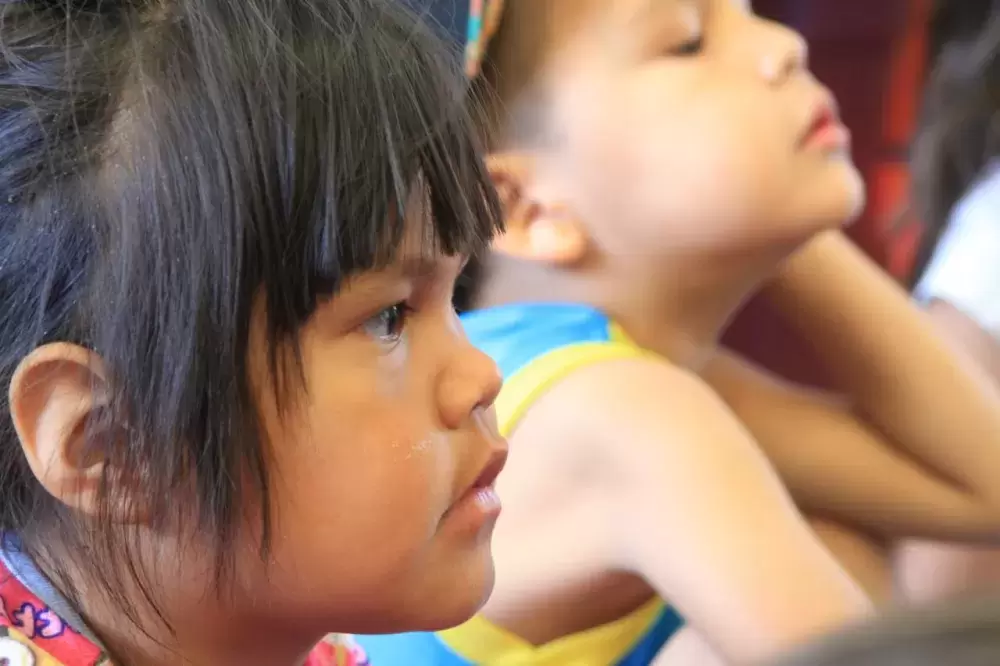A newborn lies on a blanket, surrounded by a dozen and a half kindergarten students. Each of the 5 and 6-year-olds lean in to get a closer look at how the baby reacts to the environment, keen to pick up on any clues in the infant’s facial expressions, sounds and body movements as he stares around the room and connects with his mother.
This interaction is the central component to Roots of Empathy, a program that just finished its first year at the Haahuupayak Elementary School. Through a series of exercises that assess the baby’s behavior, the school children are taught to identify emotional needs in another person, thereby fostering an ability to understand and manage their own feelings. It’s a foundation in emotional intelligence designed to decrease schoolyard bullying as well as more troublesome behaviours into adolescence and adulthood.
Nicole Rollans, an aboriginal infant development worker with the Nuu-chah-nulth Tribal Council, said the importance of the program is how it helps children understand the common emotions everyone shares.
“The baby is the teacher. The central important role of Roots of Empathy is that infant and how they interact with their mother in their first year of life,” she said. “We’re helping children to connect not only with understanding the infant-parent bond, which is so important in that first year of life, but also understanding the connection that we all have together.”
“How a mother would care for their child is how we would think about our friends,” added Carly Denning, a kindergarten teacher who has just completed the 27-session Roots of Empathy program at Haahuupayak school.
Roots of Empathy uses an newborn, aged 2-4 months, at the start of the school year. The baby comes to a classroom with the mother every three weeks. When the newborn isn’t there, students are led through pre and post-visit discussions that focus on observing the baby’s development and identifying needs. The program has been used around the world for the last two decades, and besides Haahuupayak, Roots of Empathy is being employed at elementary schools in Ahousaht, Gold River and Ucluelet as well.
In the past the Alberni School District has used Roots of Empathy to enrich the cultural environment of certain schools.
“It brings in some new enthusiasm,” said Jack Hitchings, the school district’s director of instruction for learning services. “At one point or another I’m pretty sure it’s been in all of our schools.”
Over the last school year Denning has seen an improvement in how her kindergarten class can manage their feelings and identify troubling behavior towards others.
“A big focus that I have is that kids need to express their emotions and it’s really difficult,” she said. “When they come into kindergarten, whether they’ve been in a pre-school setting or they haven’t, they still struggle with social interactions, talking to each other and how to play together.”
Roots of Empathy is based on a 639-page curriculum that can involve students as old as Grade 8. The belief is that fostering a greater ability to emotionally understand another person eventually leads to better citizens, decreasing destructive behavior such as depression, substance abuse, violent crime and abusive parenting. In 2001 the Government of Manitoba commissioned a longitudinal study on the program that indicated a reduction in acts of physical and indirect aggression three years after children had their last Roots of Empathy session.
The program also touches on disturbing conditions, like sudden infant death syndrome, shaken baby syndrome, fetal alcohol spectrum disorder and the dangers of second-hand smoke.
Denning said that if broached gently, kindergarten students can gain an understanding of tragedy.
“Our school touches on that as it is, because if there’s a death in our community, our school shuts down a lot of things and we won’t continue until the family has been asked,” she said. “They are aware of death, especially this year.”
As students make comments or express their ideas about the baby through drawings and other classroom exercises, instructors are trained to thank the children for their contributions, rather than offering praise.
“We want children to feel validation within their own selves as opposed to looking outwardly to be validated,” noted Rollans. “We want it to be a really judgement-free learning environment for them so that everyone feels comfortable contributing. We want to build a sense of community for the children.”







